|
ACT III - PART I
Demolishing a high-rise office building that has outlived its
usefulness is a daunting task. As a general rule, tall buildings
tend to grow in clusters, much like mushrooms, and the owners and
occupants of the surrounding buildings usually frown upon having
their own buildings damaged or destroyed in the process of bringing
down a neighboring building. The trick then is to get the unwanted
building to drop straight down, forming a neat pile that doesn't
extend much beyond the structure's original footprint.
That is not something that tall buildings are naturally inclined to
do. A large structure can be brought down in that manner, but it is
an extremely difficult trick to pull off. A considerable amount of
study, planning and preparation is required. Specific quantities of
explosives have to be precisely placed at key structural locations
throughout the building, and those explosive charges have to be
programmed to detonate in a specific pattern. There is almost no
margin for error. Only a handful of companies have the technical
expertise to take on such a project.
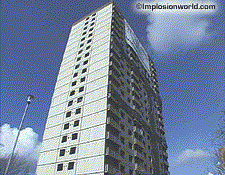 When one of these highly specialized demolition companies does their
job properly, the result is a spectacular show during which the
targeted building seems to self-destruct and simply drop away from
the skyline, as though it had never been there at all. The show is
generally over in just a few seconds, making the entire process
appear to be very quick and easy. But it is decidedly not easy. When one of these highly specialized demolition companies does their
job properly, the result is a spectacular show during which the
targeted building seems to self-destruct and simply drop away from
the skyline, as though it had never been there at all. The show is
generally over in just a few seconds, making the entire process
appear to be very quick and easy. But it is decidedly not easy.
When a building implodes (like the one to the left, which you can
click on to view a short video of another controlled implosion), all
that we as spectators see is the end result of months of research
and preparation by a team of specialists with decades of training
and experience. Buildings never implode by accident -- at least they
never did before September 11, 2001. But the south WTC tower did, at
9:59:04 AM that fateful day. And the north WTC tower did as well, at
10:28:31 AM. And then WTC7 did the very same thing, at about 5:20
PM. In less than eight hours time, three separate high-rise office
buildings allegedly did what no buildings in history have done
before: spontaneously collapsed into their own footprints.
The inexplicable collapse of the twin towers has always been the
single most compelling aspect of the events of that day --
compelling because the controlled collapses point directly to inside
involvement, and compelling because this evidence of direct U.S.
sponsorship of the attacks has always been brazenly displayed for
all to see.
The evidence suggesting that Flight 77 did not hit the Pentagon was
not immediately available, but rather was developed over a
considerable period of time. It was immediately apparent that
routine procedures for responding to potential emergencies were not
followed that day, but grasping that concept required exercising a
little independent thought, rather than just robotically processing
the propaganda blizzard of words and images that followed the
attacks.
Most people, reeling from the media assault, were unable to connect
the dots and recognize that a stand-down had occurred. And most
people have never seen the body of photographic evidence that
overwhelmingly suggests that a passenger plane did not hit the
Pentagon. Even many skeptics have not seen that evidence, thanks to
the zealous efforts of the 911 gatekeepers. But virtually everyone
saw the twin towers brought down in controlled demolitions. In fact,
most people have likely seen footage of the twin collapses replayed
dozens of times.
Perhaps what is most compelling then about the collapse of the
towers is that the very images that were seared into our brains as
reminders of the horrific nature of the attacks are the same images
that should have been presented as "Exhibit A" in the people's case
against the real perpetrators of the crimes committed that day. The
collapsed towers, in other words, are iconic symbols of the power of
media and information control.
The tower collapses, airing as the dramatic final acts in the 9-11
production, were meant to be seen. And with the knowledge that we
were witnessing, in real time, the tragic deaths of untold numbers
of victims, the images were meant to horrify and traumatize. A
traumatized subject, you see, is a receptive subject, and when you
are trying to sell the need for a fundamental shift in our
collective reality, it helps to have as many traumatized, compliant
subjects as possible. And it helps to provide images that aren't
easily forgotten.
Imagine if the twin towers had not collapsed that day. Imagine no
endlessly replayed footage of the spectacular collapses. Imagine no
footage of massive devastation. No "Ground Zero." No footage of
dazed, dust-covered New Yorkers. No instantaneous revision of the
New York skyline. No tributes to the scores of dead firefighters. No
heart-wrenching appeals from family members desperately seeking
information on relatives likely buried deep in the rubble.
Without the collapses, would the events of September 11 have had the
same impact? Would Americans, with their notoriously short memories,
still vividly recall the images and the human drama from that day,
or would we have largely moved on, giving little more thought to
September 11 than we do to the bombing of the Oklahoma City Federal
Building? Is it the loss of life that causes the events of that day
to linger in our collective memory, or is it the harrowing and
ubiquitous images of massive property destruction?
In order for the attacks of September 11 to serve as the catalyst
for a realignment of the 'group mind,' the events of that day had to
play out on a grand scale. The spectacular collapses of the towers
were, therefore, undoubtedly the most important component of the
production. But they were also the riskiest aspect of the
production, since there was no way to disguise the fact that the
collapses were, by necessity, the result of controlled demolitions.
The collapses then represented a fundamental weakness in the master
plan. Were it not for the virtually complete control exercised by
Washington over the media, both mainstream and 'alternative,' the
twin collapses would almost certainly have been recognized as an
obvious smoking gun. Of course, the perpetrators never had any
reason to doubt their ability to thoroughly control the flow of
information, both in the media and in the so-called 'skeptics
community.'
Many in that community have harshly denounced those intrepid souls
who have questioned the cause of the collapse of the World Trade
Center towers, just as they have cast aspersions on those who
question whether it was really a commercial airliner that struck the
Pentagon. From the Wilderness set the tone very early on with a post
that was up barely 48 hours after the towers hit the ground:
Credible Evidence, Expert Witness Testimony Convincing: No
Explosives Hidden in WTC
Sept 13, 2001 -- 1500 PDT
(http://www.fromthewilderness.com/free/ww3/09_13_01_No_Explosives.html)
FTW - Based upon a detailed review of an interview with a NY
architect who is expert on high rise construction and upon today's
BBC story which I have linked at the bottom of this page, I am now
virtually certain that there were no explosives placed within the
WTC buildings. The motive for such a move would have been unclear in
light of the drama and the security risks for "pre-event" compromise
posed by dual efforts that would have accomplished the same ends.
Discovery of the explosives before the hijacking would have emptied
the buildings and placed the nation on alert before the hijackings
could have been carried out. The WTC towers would have been
evacuated and that would have reduced the impact of the crashes.
Gravity would have taken all of the unburned fuel down central
shafts of the building and the physics in this story are consistent
with both witness statements and other expert interviews I have
read.
In addition, my ex-wife Mary lives a block away and witnessed both
the second crash and the collapse of both towers from a close
distance. Neither she, nor any other person she knows, heard any
explosions or believe that secondary charges were a factor in of the
collapses.
I will be posting a more detailed bulletin for my subscribers on
this shortly.
Mike Ruppert
http://news.bbc.co.uk/hi/english/world/americas/newsid_1540000/1540044.stm
The phantom New York architect was never identified. The alleged
"expert interviews" never actually existed. The BBC report was shown
to be littered with errors. And the "more detailed bulletin" never
surfaced. Instead, Ruppert allowed his hastily assembled initial
post to stand for over two years as his only commentary on the
collapse of the towers. The dust from the World Trade Center hadn't
even settled yet and already the 9-11 gatekeeper position had been
established, courtesy of Mike Ruppert and the BBC.
Before the spin had fully set in, there was one early media report,
published in the relatively obscure Albuquerque Journal, that
accurately identified the cause of the collapse of the towers:
Televised images of the attacks on the
World Trade Center suggest
that explosives devices caused the collapse of both towers, a New
Mexico Tech explosion expert said Tuesday. The collapse of the
buildings appears "too methodical" to be a chance result of
airplanes colliding with the structures, said Van Romero, vice
president for research at New Mexico Institute of Mining and
Technology.
"My opinion is, based on the videotapes, that after the
airplanes hit the World Trade Center there were some explosive
devices inside the buildings that caused the towers to collapse,"
Romero said.
Romero is a former director of the Energetic Materials
Research and Testing Center at Tech, which studies explosive
materials and the effects of explosions on buildings, aircraft and
other structures ... Romero said the collapse of the structures
resembled those of controlled implosions used to demolish old
structures.
"It would be difficult for something from the plane to
trigger an event like that," Romero said in a phone interview from
Washington, D.C. ... "It could have been a relatively small amount
of explosives placed in strategic points," Romero said.
(Albuquerque Journal, September 11, 2001)
That report would have been quickly lost in the blizzard of media
coverage of the attacks were it not for the work of Internet
researchers, particularly Jared Israel of emperors-clothes.com, who
first called attention to the story on September 14
(http://emperors-clothes.com/news/albu.htm 9-14-01) . A week later,
the Journal ran a follow-up report that found Mr. Romero radically
reversing his position:
A New Mexico explosives expert says he now believes there were no
explosives in the World Trade Center towers, contrary to comments he
made the day of the Sept. 11 terrorist attack.
"Certainly the fire
is what caused the building to fail," said Van Romero, a vice
president at the New Mexico Institute of Mining and Technology ...
Romero supports other experts, who have said the intense heat of the
jet fuel fires weakened the skyscrapers' steel structural beams to
the point that they gave way under the weight of the floors above
... Conspiracy theorists have seized on Romero's comments as
evidence for their argument that someone else, possibly the U.S.
government, was behind the attack on the Trade Center. Romero said
he has been bombarded with electronic mail from the conspiracy
theorists.
"I'm very upset about that," he said. "I'm not trying to
say anything did or didn't happen."
(Albuquerque Journal, September 21, 2001)
Those damn conspiracy theorists! What is it with them? They seem to
be forever insisting that the stories told to the American people by
our media guardians actually make sense and reflect some kind of
objective reality. On September 14, the same day that the
Albuquerque Journal article hit the Internet, The Financial Times
added further fuel to the conspiracy fire:
The owners of the demolished World Trade Center in lower Manhattan
acquired the buildings just two months ago under a 99-year lease
allowing them to walk away from their investment in the event of "an
act of terrorism." The owners, Silverstein Properties and
Westfield
America - a shopping mall specialist - purchased the buildings from
the Port Authority of New York and New Jersey for $3.2bn in July and
completed the financing just two weeks ago ... It is understood that
the buildings are insured for more than $3bn, enough to cover
rebuilding costs.
(The Financial Times Limited, September 14, 2001)
Though it seems to be forgotten now, it was only through their
destruction that the twin towers were transformed into beloved
symbols of America. Prior to September 11, 2001, most New Yorkers
would have been quite happy to see the towers disappear from the
city's skyline, albeit in a less deadly and destructive manner.
Controversial when first proposed and considered an eyesore upon
completion, the towers never really captured the hearts of the
city's inhabitants. And they were never really necessary, judging by
the chronically high office vacancy rates in lower Manhattan.
On the morning of September 11, the World Trade Center towers hit
the ground at an estimated 124-miles-per-hour, less than ten seconds
after they first began to collapse. They were, in other words,
virtually in free-fall. Once the collapses had begun, the 200,000
tons of steel and nearly 500,000 cubic yards of concrete that
supported the massive structures seemed to offer no resistance at
all. In just seconds, 10,000,000 square feet of commercial office
space simply ceased to exist.
We all watched it happen, just three short years ago, but it is
still difficult to believe that two 110-story monoliths, stretching
a quarter-mile into the sky, were reduced to a 1.8-million-ton pile
of rubble that stood, at its tallest points, just 60 feet high. In
under ten seconds.
What has never been in dispute is that the fall of the south tower,
just 56 minutes after it had been hit, marked the first time in
history that a steel-framed high-rise structure had suffered a total
collapse due to fire. Never before had such a building suffered even
a partial collapse due to fire. At 10:28 AM, the north tower became
the second steel-framed high-rise structure to suffer a total
collapse due to fire.
The twin towers were certainly not the first high-rise structures to
ever sustain significant damage from a fire. Nor were they the first
steel-framed buildings to be struck by errant aircraft. Various
buildings around the world, including the Empire State Building,
have been hit by airplanes of various size. And countless
steel-framed buildings around the world have been hit by
U.S.-launched cruise missiles and guided bombs. None of them have
ever suffered a complete collapse, even after sustaining multiple
impacts.
To explain the unprecedented series of events that unfolded on
September 11, 2001, 'experts' trotted out by the media have posited
that the photogenic collapses resulted from an historically unique
combination of three factors: the initial damage inflicted on the
towers by the airplane crashes; the damage caused by what were said
to be intense fires; and the unconventional “tubular” design of the
twin towers.
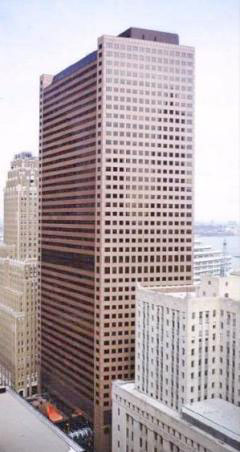 These experts, however, have offered no explanation for why the
building known as #7 World Trade Center - a conventional
steel-framed high-rise structure that was not hit by a plane -
became, at approximately 5:20 PM on September 11, 2001, the third
high-rise structure in recorded history to suffer a complete collapse
due to fire. FEMA struggled to find an explanation to include in a
report on the collapses, but came up short: These experts, however, have offered no explanation for why the
building known as #7 World Trade Center - a conventional
steel-framed high-rise structure that was not hit by a plane -
became, at approximately 5:20 PM on September 11, 2001, the third
high-rise structure in recorded history to suffer a complete collapse
due to fire. FEMA struggled to find an explanation to include in a
report on the collapses, but came up short:
“The specifics of the
fires in WTC 7 and how they caused the building to collapse remain
unknown at this time.”
(http://www.fema.gov/library/wtcstudy.shtm)
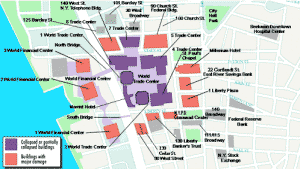
(click image to
enlarge)
Though dwarfed by the massive twin towers, WTC7 was an imposing
structure that would have dominated the skyline of many large
cities. Built in 1985, it was a modern, 47-story structure that
housed 1,868,000 square feet of commercial office space, much of it
occupied by governmental agencies bearing three-letter acronyms,
including the CIA.
Some have suggested that WTC7 collapsed due to damage caused by
debris from the falling towers, particularly the north tower. That
does not appear to be the case, however, since photos and video of
the building taken in the hours after the collapse of the towers
show that WTC7 was quite intact prior to its collapse. There is also
the curious fact that WTC6, which sat between WTC7 and the towers,
somehow managed to avoid suffering a complete collapse that day.
Some reports, including the BBC report cited earlier by Ruppert,
seemed to imply that the building's foundation had perhaps been
"weakened by the earlier collapses." But if that had been the case,
WTC7 would not have dropped straight down, as though sinking into
the ground; it would have toppled over, taking out neighboring
buildings in the process. The BBC report also warned that "more
nearby buildings may still fall," as though it had suddenly become
commonplace for tall buildings to spontaneously convert themselves
into neat piles of debris.
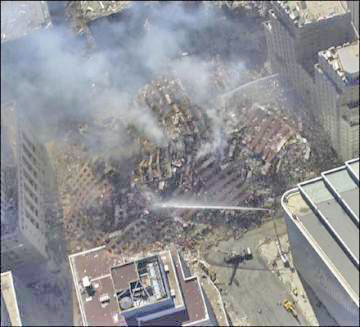 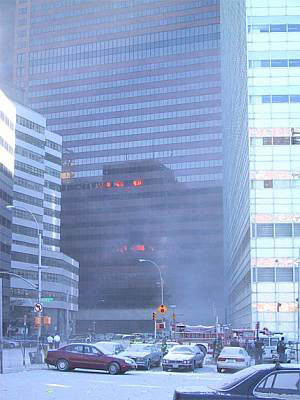
Fires purportedly raged within WTC7 for hours before the building
collapsed, but the source of the fires remains largely a mystery, as
does the complete failure of the building's modern sprinkler system,
which should have been more than adequate to contain any fires.
Considering the intense media attention that was focused on lower
Manhattan that day, still photos or video footage of WTC7 engulfed
in flames are curiously hard to find. Photos of the building taken
not long before the collapse (such as the one to the
upper right)
reveal only small pockets of fire that were confined to two floors.
 World Trade Center #7 hit the ground, reduced to a neat pile of
rubble, in approximately seven seconds. Like the twin towers, it was
in virtual free-fall. Also like the towers, WTC7 collapsed into its
own footprint with absolutely uncanny precision. It is no accident
that the American people, although bombarded with images of the
collapsing towers, have never seen footage of the collapse of WTC7.
It is nearly impossible to watch video footage of the collapse and
fail to recognize it for what it is: a deliberate, and perfectly
executed, controlled implosion. [Click on below control
panels to view video clips of the collapse from two different vantage
points.] World Trade Center #7 hit the ground, reduced to a neat pile of
rubble, in approximately seven seconds. Like the twin towers, it was
in virtual free-fall. Also like the towers, WTC7 collapsed into its
own footprint with absolutely uncanny precision. It is no accident
that the American people, although bombarded with images of the
collapsing towers, have never seen footage of the collapse of WTC7.
It is nearly impossible to watch video footage of the collapse and
fail to recognize it for what it is: a deliberate, and perfectly
executed, controlled implosion. [Click on below control
panels to view video clips of the collapse from two different vantage
points.]
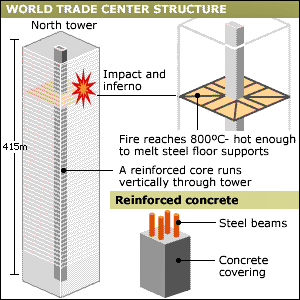 The official explanation for the collapse of the
twin towers (WTC7 is rarely mentioned) is that the steel and concrete floor slabs, in
the areas of the towers damaged by the initial plane crashes, broke
free and collapsed down upon the floors below, which then in turn
broke free and collapsed, thus creating an alleged 'pancake' effect
that quickly gained mass and speed. Once the floors broke free, so
the story goes, the outer steel shells of the towers lost structural
integrity and collapsed in upon the pancaking floor sections. The official explanation for the collapse of the
twin towers (WTC7 is rarely mentioned) is that the steel and concrete floor slabs, in
the areas of the towers damaged by the initial plane crashes, broke
free and collapsed down upon the floors below, which then in turn
broke free and collapsed, thus creating an alleged 'pancake' effect
that quickly gained mass and speed. Once the floors broke free, so
the story goes, the outer steel shells of the towers lost structural
integrity and collapsed in upon the pancaking floor sections.
There are a few very obvious problems with this 'pancake' theory.
First, there is the question of whether fires raged in the towers at
sufficient intensity, and for a sufficient amount of time, to cause
the failure of the floor trusses. All of the images captured that
day show that at the time of the collapses, the towers were
billowing copious amounts of thick, black smoke -- indicative not of
raging infernos, but of low intensity, smoldering office fires.
Transcripts of fire department audiotapes indicate that firefighters
on the scene reported only pockets of low intensity fire that posed
no danger to the structural integrity of the building.
(http://www.thememoryhole.org/911/firefighter-tape-excerpts.htm)
The graphic to the above right, published with the previously cited
BBC
report, was supposed to help the public understand what caused the
collapse of the towers. The illustration, however, contained obvious
errors, including the claim that the fires reached "800° C - hot
enough to melt steel floor supports." There is no indication that
the fires burning in the towers reached such temperatures -- and
even if they did, steel doesn't actually melt at 800° C (about
1,500° F); it melts at about 1,500° C (about 2,750° F).
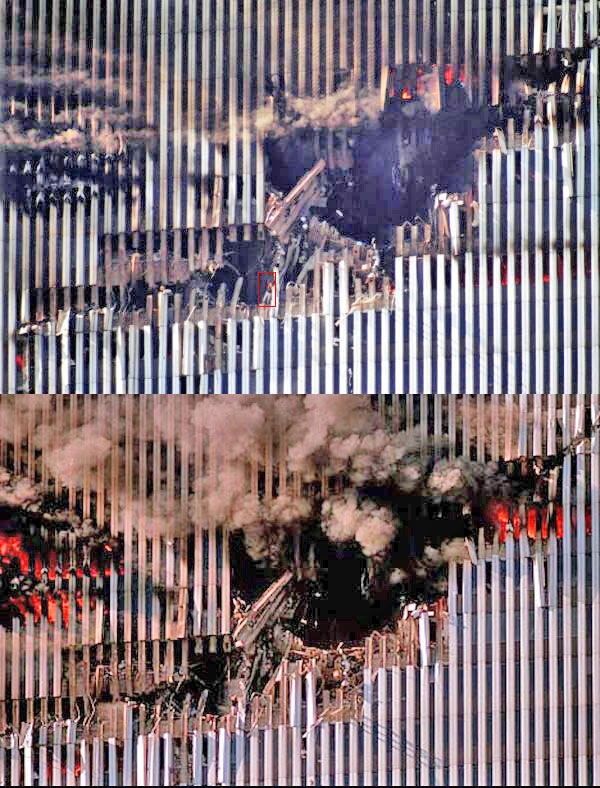
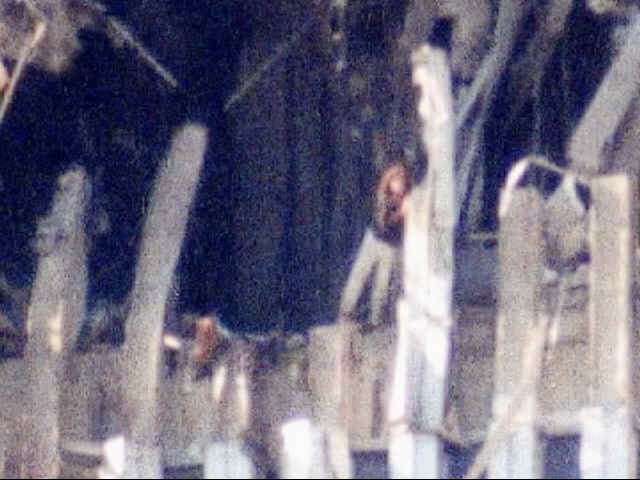
The text of the BBC report contained this curious claim: "the
towers' ultimate collapse was inevitable, as the steel cores inside
them reached temperatures of 800C - raising questions as to why
hundreds of rescue workers were sent into the doomed buildings to
their deaths." Actually, if the claim about the core temperatures
were true, it would have raised questions as to how hundreds of
rescue workers were sent into the doomed buildings to their deaths,
since the only way up was through the building cores, where all the
stairwells and elevators were located.
Perhaps the best evidence refuting the notion that the fires in the
WTC towers were burning at extremely high temperatures can be found
through close examination of the pre-collapse photos
above.
Near the center of the gaping entry wound (which looks much
different, by the way, than the phantom entry wound in the Pentagon)
stands the tragic figure of an apparently young woman still very
much alive -- and seemingly unaware that she is clinging to a piece
of nearly molten metal.
Technically speaking, the 'pancake' theory does not require that the
fires reached temperatures capable of melting steel; it requires
only that temperatures were high enough to substantially weaken the
steel floor supports. A 1500° F fire could conceivably accomplish
that task, if that temperature was maintained for a considerable
amount of time. But there is no indication from firefighter reports,
survivor reports, or the photographic evidence that there were any
fires of that magnitude that burned for any appreciable length of
time.
Another problem with the 'pancake' theory is that it fails to
address the fate of the cores of the two towers. Contrary to the
deceptive BBC graphic, the cores of the WTC towers occupied a
considerable portion of the buildings' footprints, as can be seen in
the accurately scaled graphic below, and in the
photo further below, taken while the towers were under construction.
These configurations of 47 massive steel support columns, heavily
cross-braced, were designed to not only be self-supporting, but to
support the floors and exterior walls as well.
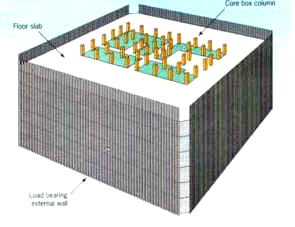 Even if we accept that the floor slabs somehow ‘pancaked,’ and that
the outer steel and aluminum shells then buckled and collapsed, we
are left with no explanation of what happened to those massive
concrete and steel cores. Clearly, the floor slabs were hardly the
wide-open 'pancakes' depicted in deceptive media graphics. In truth,
the 'pancake' theory, at best, offers only an explanation of how the
floor and exterior wall sections may have collapsed. Even if such an
extremely unlikely event had occurred, the end result would not have
been a 60-foot-high mound of rubble; it would have been two 137' x
87' x 1,360' towers standing in place of two 208' x 208' x 1,360'
towers. Even if we accept that the floor slabs somehow ‘pancaked,’ and that
the outer steel and aluminum shells then buckled and collapsed, we
are left with no explanation of what happened to those massive
concrete and steel cores. Clearly, the floor slabs were hardly the
wide-open 'pancakes' depicted in deceptive media graphics. In truth,
the 'pancake' theory, at best, offers only an explanation of how the
floor and exterior wall sections may have collapsed. Even if such an
extremely unlikely event had occurred, the end result would not have
been a 60-foot-high mound of rubble; it would have been two 137' x
87' x 1,360' towers standing in place of two 208' x 208' x 1,360'
towers.
Yet another problem with the ‘pancake’ theory is that it is wholly
dependent on a perfectly symmetrical failure of the floor slabs,
even though the initial damage to the buildings was clearly
asymmetrical, and the fires certainly did not burn uniformly
throughout the damaged floors.
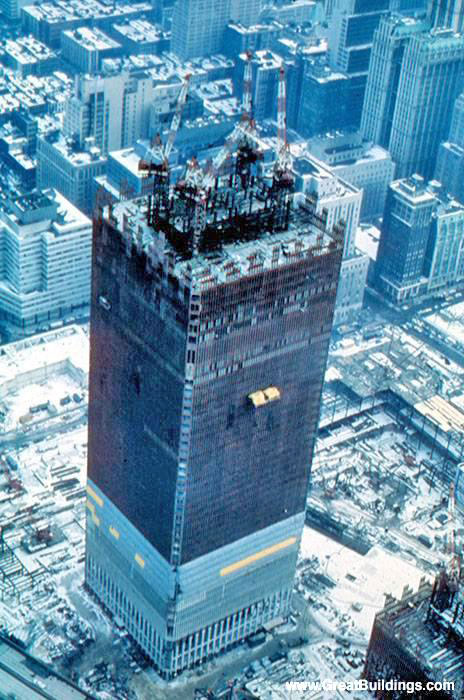
And yet we know that for the
destruction to be complete, the collapse of the initial floor slabs
would have had to be perfectly uniform; every point of connection
around the perimeter of the core, and every point of connection
around the exterior shell, would have had to fail at precisely the
same moment in time. And each successive floor would have had to
fail in exactly the same perfectly uniform manner, unerringly, all
the way down the line. When the ‘pancake’ effect has to course
through 110 floors, there isn't really any margin for error. And yet
both towers, as we all know, 'pancaked' into oblivion in matching,
perfectly choreographed collapses.
Remarkably enough, the two towers somehow collapsed in exactly the
same manner even though the initial damage to each tower was quite
different. The plane that hit the north tower plowed straight into
the center of the north face of the tower, and then straight into
the center of the tower's core. The south tower, however, was hit
with more of a glancing blow, through the southeast corner of the
building, in such a way that the plane likely did minimal damage to
the tower's core. Nevertheless, the damage to the south tower may
have been more significant than the damage to the north tower. In
the north tower, the weight of the upper floors was transferred to
the remaining structural elements of the north wall of the tower.
But in the south tower, since it was a corner of the building that
was blown out, there was nowhere for the load to be transferred.
Also, the south tower was hit at a lower elevation, so there was
more weight bearing on the damaged area.
It is interesting to note here, by the way, that in both tower
crashes, the initial impacts caused structural damage on at least
six floors. The south tower was impacted on floors 78-84, and the
north tower on floors 93-98. The Pentagon, on the other hand,
miraculously sustained impact damage on just two floors...
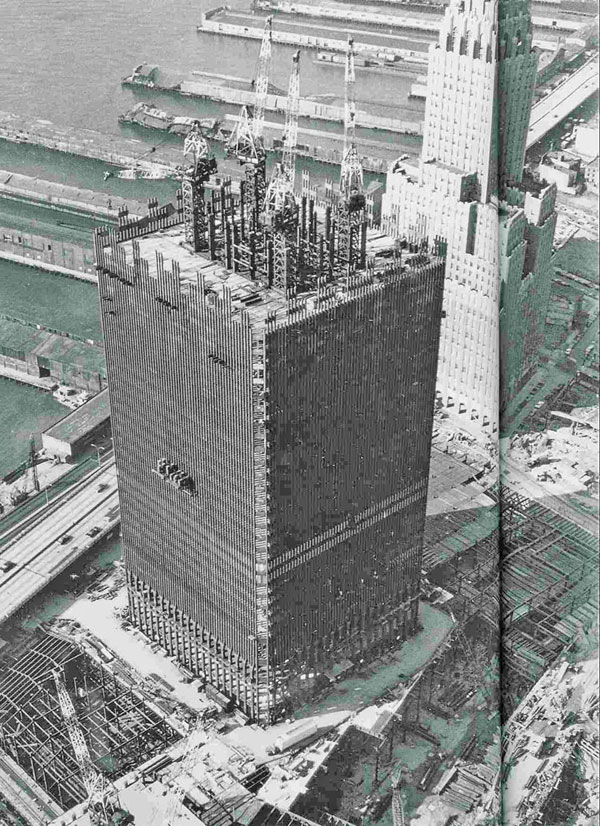
(for extra large size
click image)
|
 When one of these highly specialized demolition companies does their
job properly, the result is a spectacular show during which the
targeted building seems to self-destruct and simply drop away from
the skyline, as though it had never been there at all. The show is
generally over in just a few seconds, making the entire process
appear to be very quick and easy. But it is decidedly not easy.
When one of these highly specialized demolition companies does their
job properly, the result is a spectacular show during which the
targeted building seems to self-destruct and simply drop away from
the skyline, as though it had never been there at all. The show is
generally over in just a few seconds, making the entire process
appear to be very quick and easy. But it is decidedly not easy. These experts, however, have offered no explanation for why the
building known as #7 World Trade Center - a conventional
steel-framed high-rise structure that was not hit by a plane -
became, at approximately 5:20 PM on September 11, 2001, the third
high-rise structure in recorded history to suffer a complete collapse
due to fire. FEMA struggled to find an explanation to include in a
report on the collapses, but came up short:
These experts, however, have offered no explanation for why the
building known as #7 World Trade Center - a conventional
steel-framed high-rise structure that was not hit by a plane -
became, at approximately 5:20 PM on September 11, 2001, the third
high-rise structure in recorded history to suffer a complete collapse
due to fire. FEMA struggled to find an explanation to include in a
report on the collapses, but came up short: 


 World Trade Center #7 hit the ground, reduced to a neat pile of
rubble, in approximately seven seconds. Like the twin towers, it was
in virtual free-fall. Also like the towers, WTC7 collapsed into its
own footprint with absolutely uncanny precision. It is no accident
that the American people, although bombarded with images of the
collapsing towers, have never seen footage of the collapse of WTC7.
It is nearly impossible to watch video footage of the collapse and
fail to recognize it for what it is: a deliberate, and perfectly
executed, controlled implosion. [Click on below control
panels to view video clips of the collapse from two different vantage
points.]
World Trade Center #7 hit the ground, reduced to a neat pile of
rubble, in approximately seven seconds. Like the twin towers, it was
in virtual free-fall. Also like the towers, WTC7 collapsed into its
own footprint with absolutely uncanny precision. It is no accident
that the American people, although bombarded with images of the
collapsing towers, have never seen footage of the collapse of WTC7.
It is nearly impossible to watch video footage of the collapse and
fail to recognize it for what it is: a deliberate, and perfectly
executed, controlled implosion. [Click on below control
panels to view video clips of the collapse from two different vantage
points.] The official explanation for the collapse of the
twin towers (WTC7 is rarely mentioned) is that the steel and concrete floor slabs, in
the areas of the towers damaged by the initial plane crashes, broke
free and collapsed down upon the floors below, which then in turn
broke free and collapsed, thus creating an alleged 'pancake' effect
that quickly gained mass and speed. Once the floors broke free, so
the story goes, the outer steel shells of the towers lost structural
integrity and collapsed in upon the pancaking floor sections.
The official explanation for the collapse of the
twin towers (WTC7 is rarely mentioned) is that the steel and concrete floor slabs, in
the areas of the towers damaged by the initial plane crashes, broke
free and collapsed down upon the floors below, which then in turn
broke free and collapsed, thus creating an alleged 'pancake' effect
that quickly gained mass and speed. Once the floors broke free, so
the story goes, the outer steel shells of the towers lost structural
integrity and collapsed in upon the pancaking floor sections. 

 Even if we accept that the floor slabs somehow ‘pancaked,’ and that
the outer steel and aluminum shells then buckled and collapsed, we
are left with no explanation of what happened to those massive
concrete and steel cores. Clearly, the floor slabs were hardly the
wide-open 'pancakes' depicted in deceptive media graphics. In truth,
the 'pancake' theory, at best, offers only an explanation of how the
floor and exterior wall sections may have collapsed. Even if such an
extremely unlikely event had occurred, the end result would not have
been a 60-foot-high mound of rubble; it would have been two 137' x
87' x 1,360' towers standing in place of two 208' x 208' x 1,360'
towers.
Even if we accept that the floor slabs somehow ‘pancaked,’ and that
the outer steel and aluminum shells then buckled and collapsed, we
are left with no explanation of what happened to those massive
concrete and steel cores. Clearly, the floor slabs were hardly the
wide-open 'pancakes' depicted in deceptive media graphics. In truth,
the 'pancake' theory, at best, offers only an explanation of how the
floor and exterior wall sections may have collapsed. Even if such an
extremely unlikely event had occurred, the end result would not have
been a 60-foot-high mound of rubble; it would have been two 137' x
87' x 1,360' towers standing in place of two 208' x 208' x 1,360'
towers.
